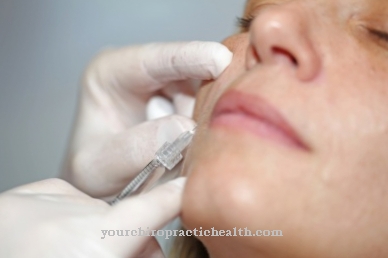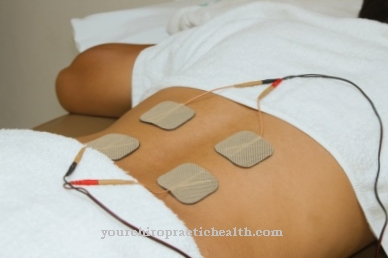As a First trimester screening is an examination method for estimating a possible chromosomal aberration in a fetus. The screening includes a biochemical blood analysis of the pregnant woman and an ultrasound examination of the unborn child. The first trimester screening is not used to establish a reliable diagnosis, but only to assess the risk.
What is first trimester screening?

The first trimester screening is a systematic examination to filter out abnormalities that indicate a prenatal risk probability. Screening is done in the first trimester (the first trimester of pregnancy) to look for a possible chromosomal abnormality in a fetus.
A chromosomal disorder can be diagnosed in the form of trisomy 21 in the first 3 months of the 9-month pregnancy through further examinations. The first trimester screening is a non-invasive method to determine an increased risk of trisomy 21 (Down's syndrome) in the unborn child and is a reliable examination with regard to the detection with a high detection rate. So-called "integrated screening" and "sequential screening" are often used as alternative diagnostic methods to first trimester screening.
During the first trimester screening, two biochemical values are determined and assessed from the mother's blood. Furthermore, an ultrasound of the fetal neck transparency is carried out and measured. Neck transparency is an accumulation of fluid between the skin and the soft tissues in the cervical spine area in the unborn child. To these results, the mother's medical history is added. Based on this information, the treating specialist can assess the result and weigh up a risk probability. However, the resulting prognosis must not be confused with a reliable diagnosis. Further clinical tests are necessary to diagnose Down syndrome.
Function, effect & goals
Before a first trimester screening, the parents-to-be should consider to what extent the assessment of a possible chromosomal abnormality is helpful and what consequences this may have for the further course of the pregnancy.
The probability calculation is made up of the age of the pregnant woman, the week of pregnancy and any existing chromosomal disorders within the family. In addition, the results of the neck fold measurement, the concentration of the protein PAPP-A and the hormone ß-hCG (human chorionic gonadotropin), representation of the nasal bone in the fetus and the blood flow in the heart and in the large blood vessels of the unborn child are assessed. During the biochemical evaluation of the laboratory values, the concentration of the protein PAPP-A and that of the hormone ß-hCG in the maternal blood are analyzed. Pregnancy-associated plasma protein A (PAPP-A) is a zinc-binding protein and works like an enzyme.
If the concentration of PAPP-A in the maternal blood is too low, this can be an indication of intruterine growth retardation. Human chorionic gonadotropin (hCG) is a pregnancy hormone that is released in the mother's body shortly after fertilization. The ß-hCG sub-category is specific for the hormone and has 145 amino acids. If these values deviate from the statistical norm during the 11-13 week of pregnancy, the risk of an anomaly increases.
In combination with the measurement of the fetal water retention in the cervical area by means of ultrasound, this is equated to a large number of already known normal values of pregnancies with positive and negative diagnoses. This enables a possible fetal chromosome aberration to be weighed up, but only as a risk assessment. However, this assessment modifies an existing high-risk pregnancy if the mother is old or if it is repeated after previous pregnancies with fetal Down's syndrome.
All values of the anamnesis and the first trimester screening are evaluated by a special computer program and finally assessed by the specialist. If the specialist determines that the limit values have been exceeded and thus an increased likelihood, a chorionic villus sampling or amniocentesis (amniocentesis) should be performed to clarify the situation. The advantage of a chorionic villus sampling is that it can be done earlier than an amniotic fluid test. However, both types of examination are invasive procedures that involve risks for the pregnant woman and the unborn child. The risk of miscarriage during such an examination is around 0.3 - 1%.
The first trimester screening detects 95 out of 100 unborn babies with Down syndrome and is therefore 95 percent informative. Nevertheless, 5 out of 100 healthy unborn babies are also incorrectly recorded as having an increased risk of trisomy 21.
Risks, side effects & dangers
The withdrawal of blood and the sonography during the first trimester screening are harmless for the pregnant woman and for the fetus. The actual consequences result from the theory of risk assessment, which the first trimester screening evokes.
The screening does not provide a reliable result and this can lead to uncertainties or even wrong decisions by the parents-to-be. Furthermore, there are many factors that influence the value of the concentration in the blood and thus make the result unusable. In a multiple pregnancy, the level of the pregnancy hormone ß-hCG and the pregnancy-associated plasma protein A (PAPP-A) is generally increased. Even women who smoke or follow a vegetarian / vegan diet during pregnancy show an increased ß-hCG value, although the unborn child is healthy.
In addition, an imprecisely calculated duration of pregnancy, obesity and diabetes mellitus can influence the values in the pregnant woman. Furthermore, a delayed development of the fetus, a placental insufficiency and a renal insufficiency of the expectant mother can be the cause of a falsified result. If there is sufficient evidence of an increased risk, this should be followed up with an amniocentesis or a chorionic villus sampling. If there is insufficient evidence, such a risky procedure should not be carried out.













.jpg)

.jpg)
.jpg)











.jpg)